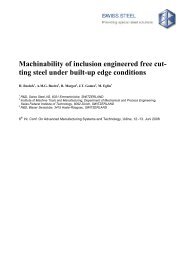Application of Thermodynamic Model for Inclusion Control in ...
Application of Thermodynamic Model for Inclusion Control in ...
Application of Thermodynamic Model for Inclusion Control in ...
Create successful ePaper yourself
Turn your PDF publications into a flip-book with our unique Google optimized e-Paper software.
Process Metallurgy – Steelmak<strong>in</strong>g<br />
ganese <strong>in</strong> the melt are summarised respectively <strong>in</strong> table 1.<br />
Though silicon deoxidation is the most important one <strong>for</strong><br />
produc<strong>in</strong>g glassy oxide <strong>in</strong>clusions <strong>in</strong> LCFCS steel mak<strong>in</strong>g,<br />
the compet<strong>in</strong>g reactions <strong>in</strong> the presence <strong>of</strong> alum<strong>in</strong>ium, calcium<br />
and manganese <strong>in</strong> the melt are <strong>in</strong>cluded <strong>in</strong> the table.<br />
The products <strong>of</strong> deoxidation reactions are complex, <strong>in</strong>volv<strong>in</strong>g<br />
a multi-component oxide system. There<strong>for</strong>e, the data <strong>of</strong><br />
component activities <strong>in</strong> the melt as well as <strong>in</strong> oxide systems<br />
are necessary <strong>for</strong> the calculation <strong>of</strong> the reactions <strong>in</strong> LMF.<br />
Calculation <strong>of</strong> Activities. The thermodynamic model<br />
calculates element and component activities, respectively <strong>in</strong><br />
melt and <strong>in</strong> oxide system, due to the chemical reactions <strong>in</strong><br />
LMF tak<strong>in</strong>g <strong>in</strong>to account Ca, Al, Si, Mn and O.<br />
In the melt the activity <strong>of</strong> element i <strong>in</strong> steel can be calculated<br />
as<br />
ai = fi[%i] (3)<br />
where [%i] is the weight percent <strong>of</strong> dissolved element i <strong>in</strong><br />
the melt. fi is the activity coefficient <strong>of</strong> i, which is calculated<br />
by the <strong>in</strong>teraction coefficient method as given below:<br />
here e j<br />
i<br />
log fi =<br />
and r j<br />
i<br />
n�<br />
j=2<br />
+<br />
e j<br />
i [% j] +<br />
n�<br />
j=2<br />
n�<br />
k=2<br />
j










